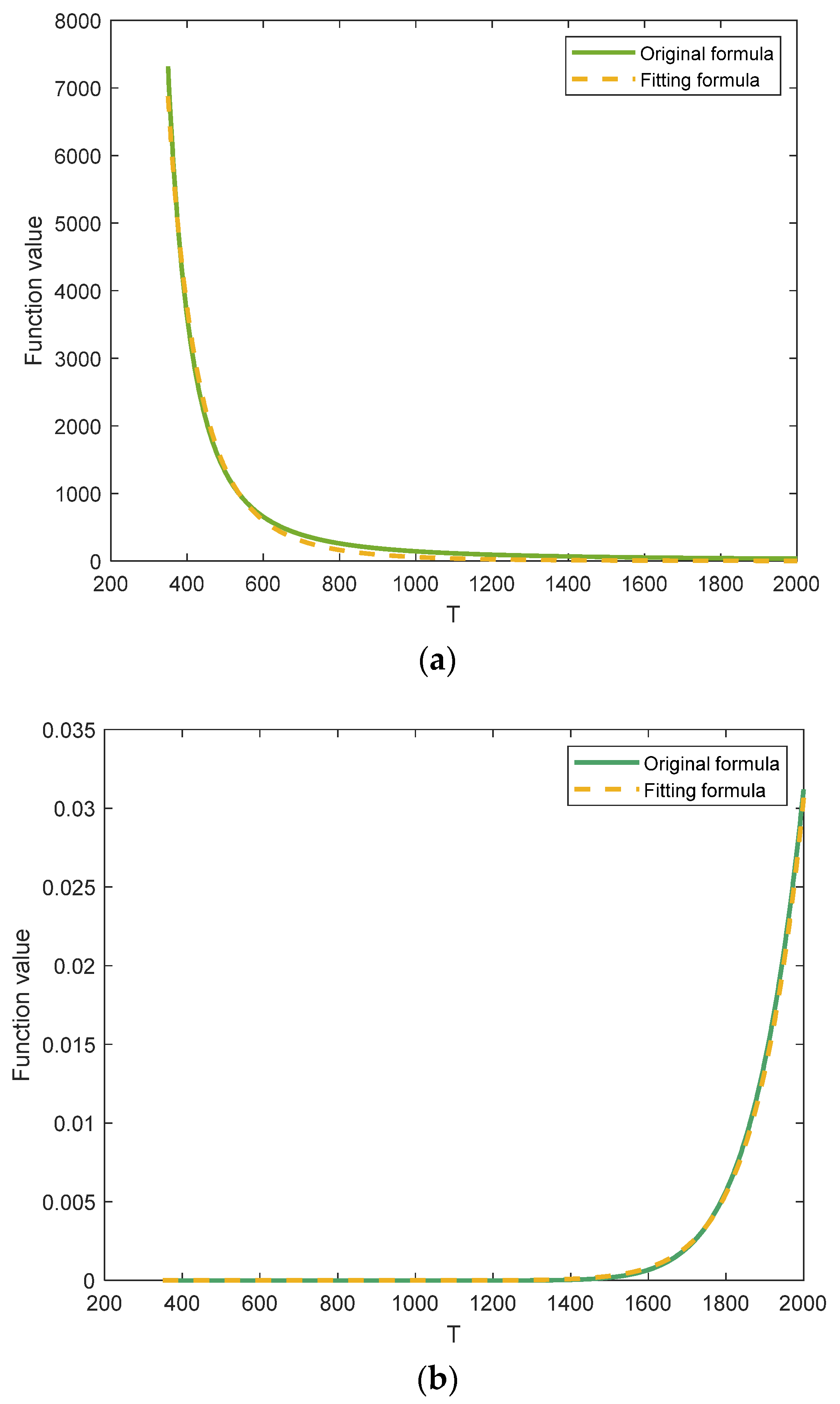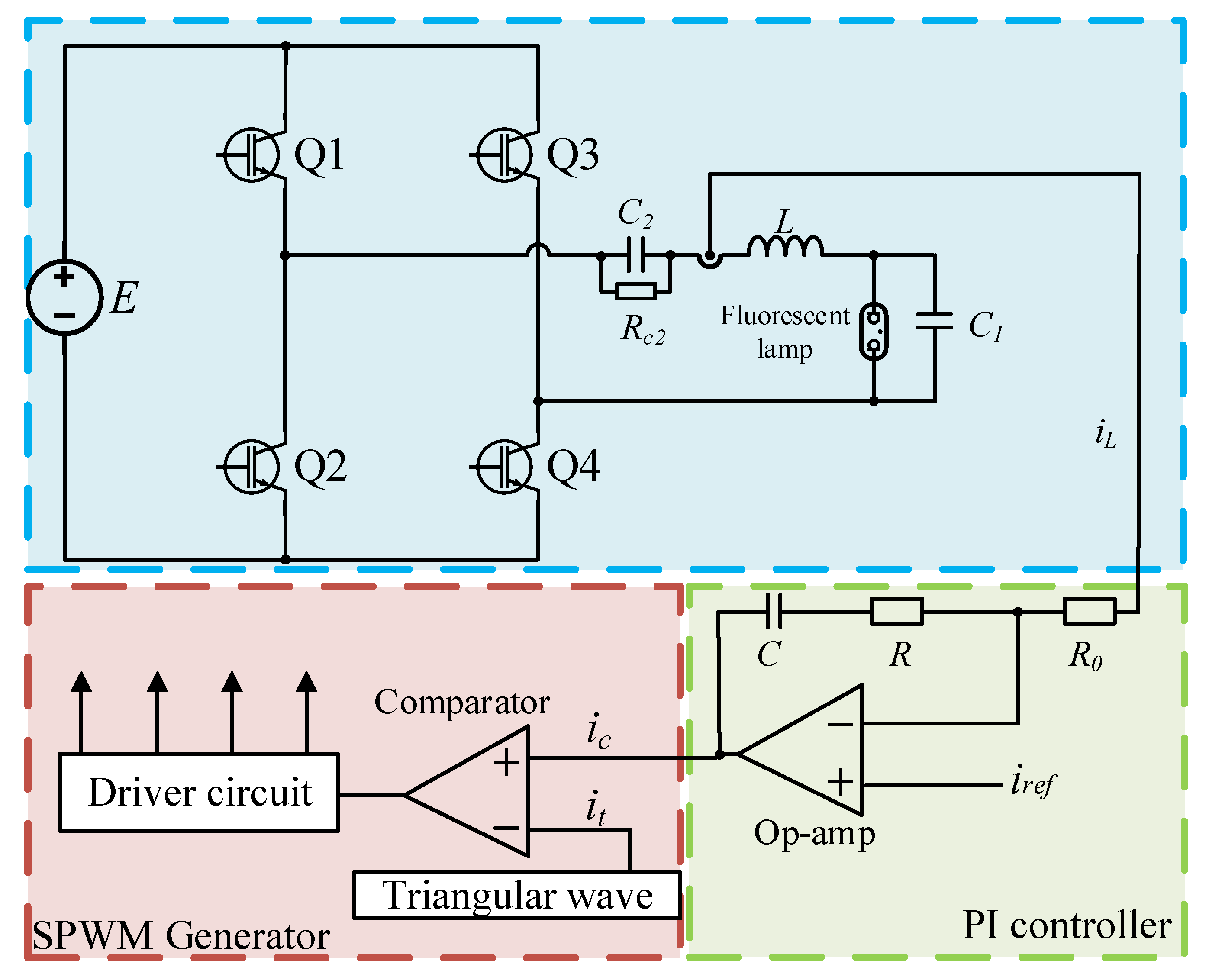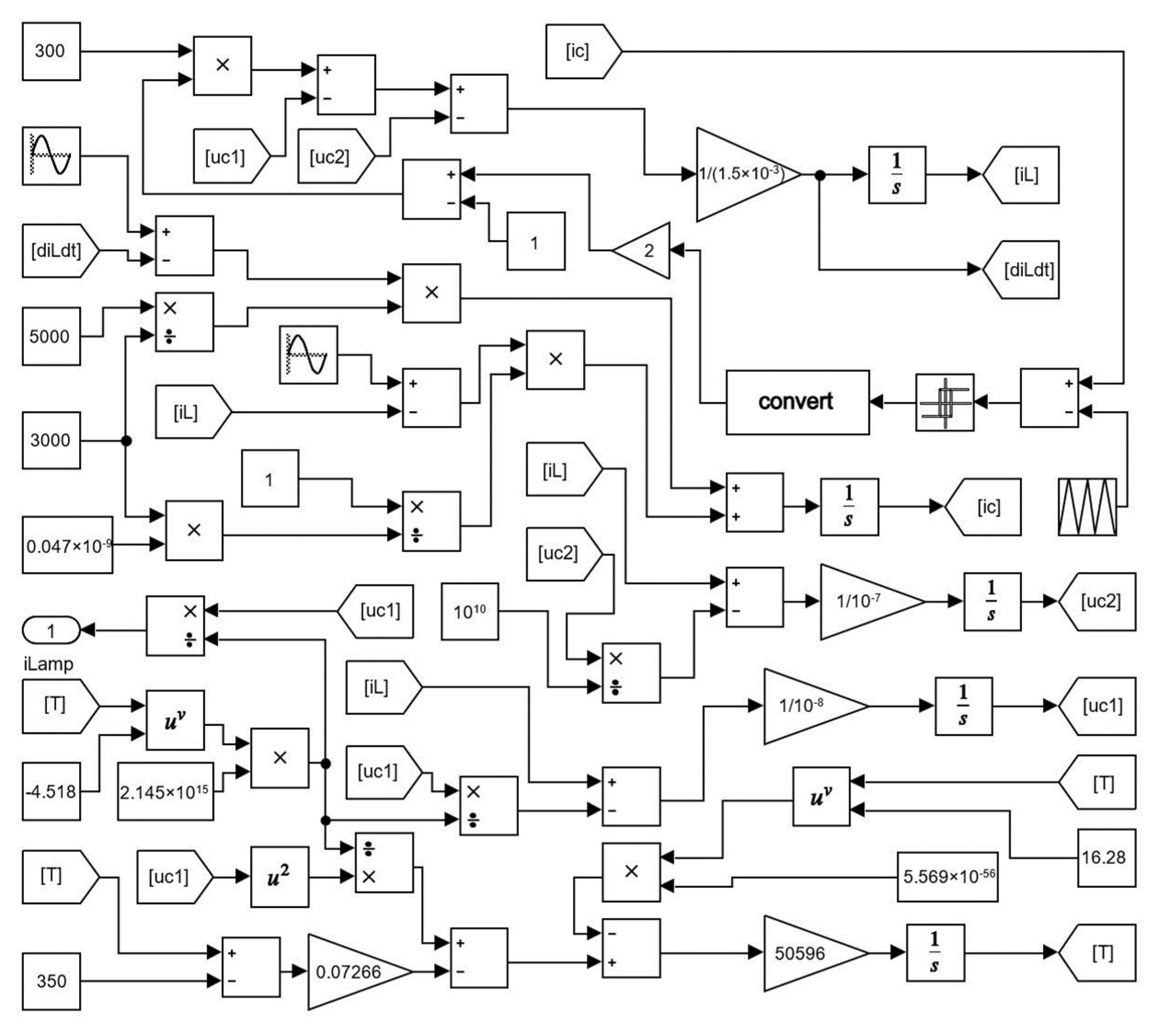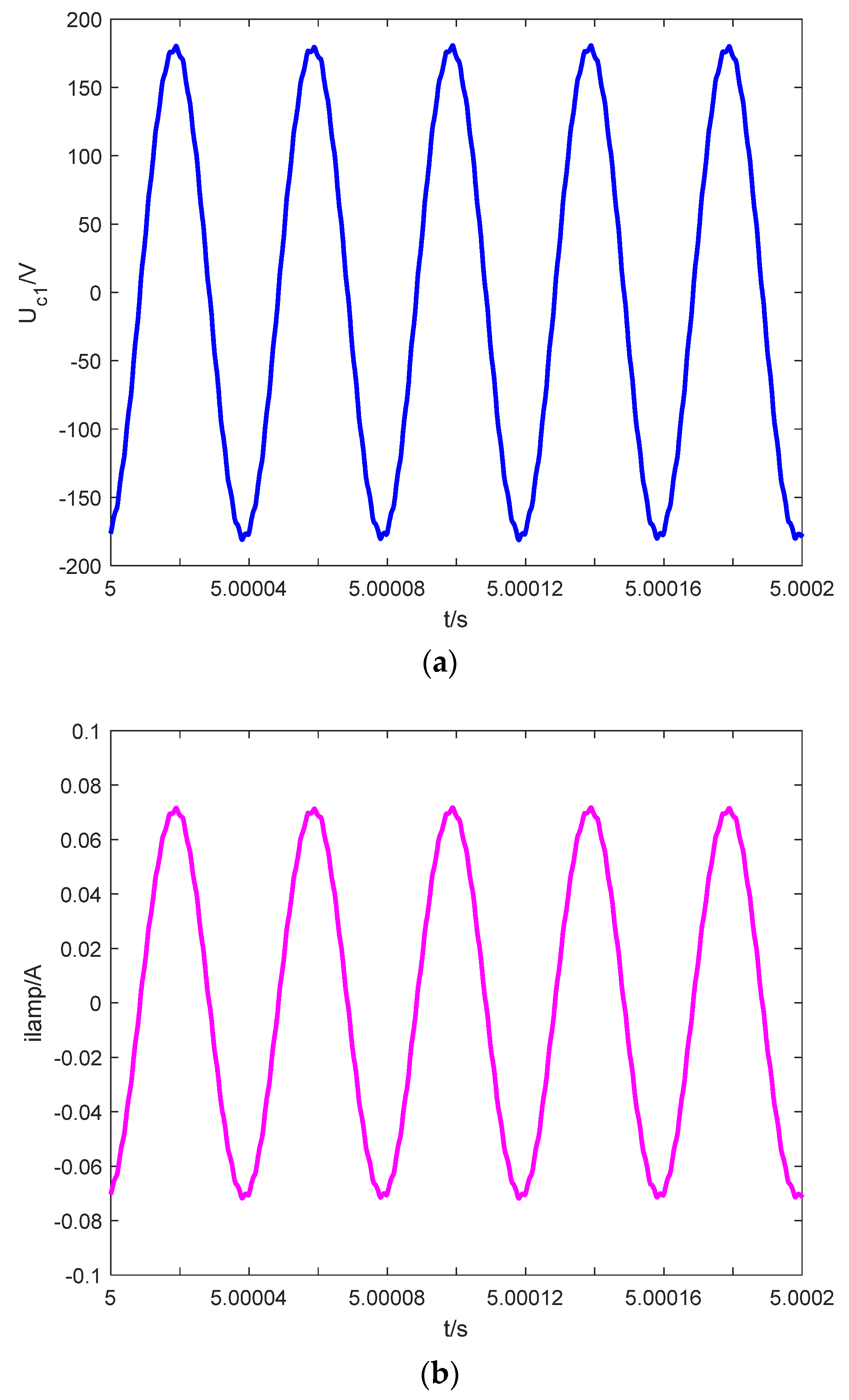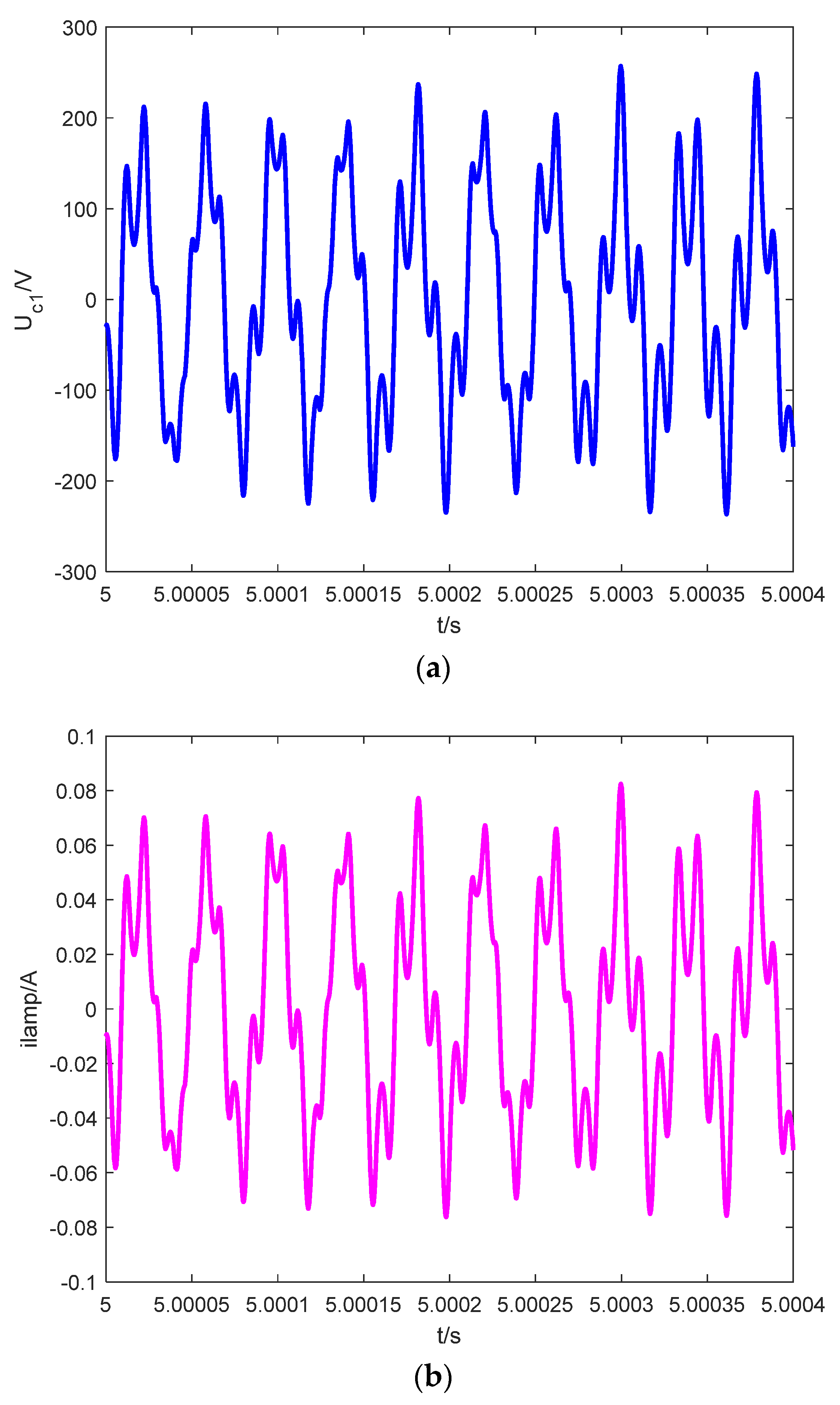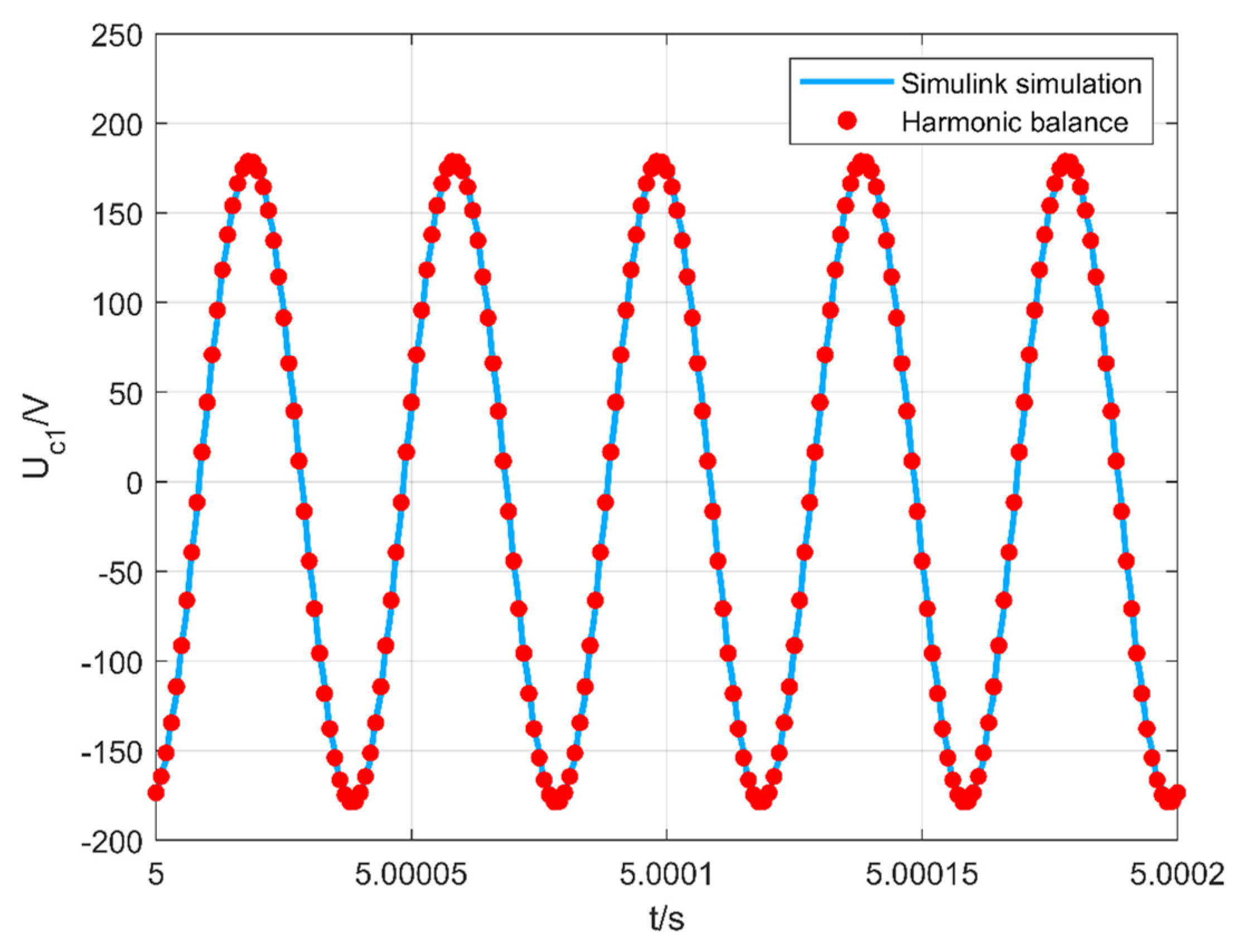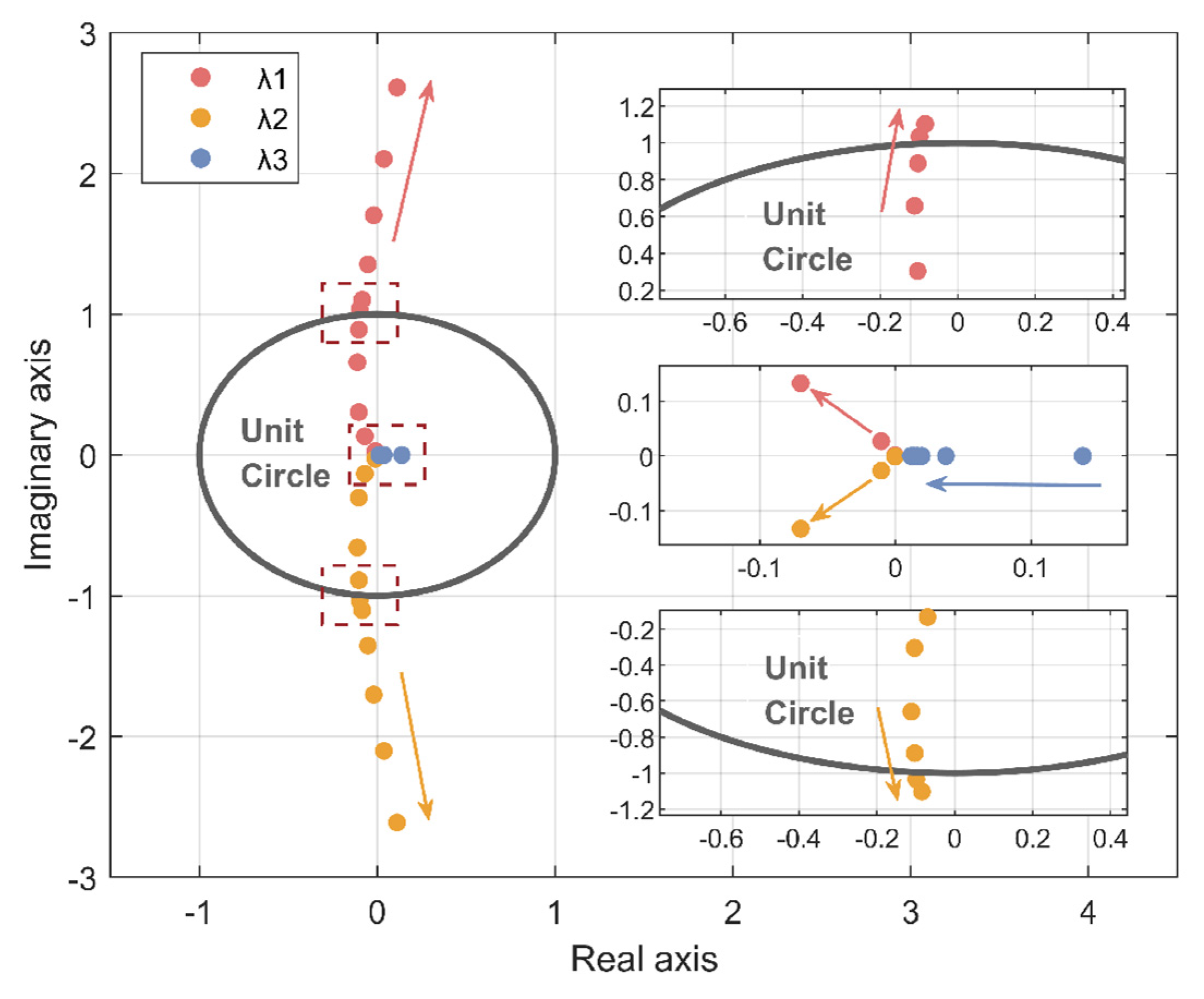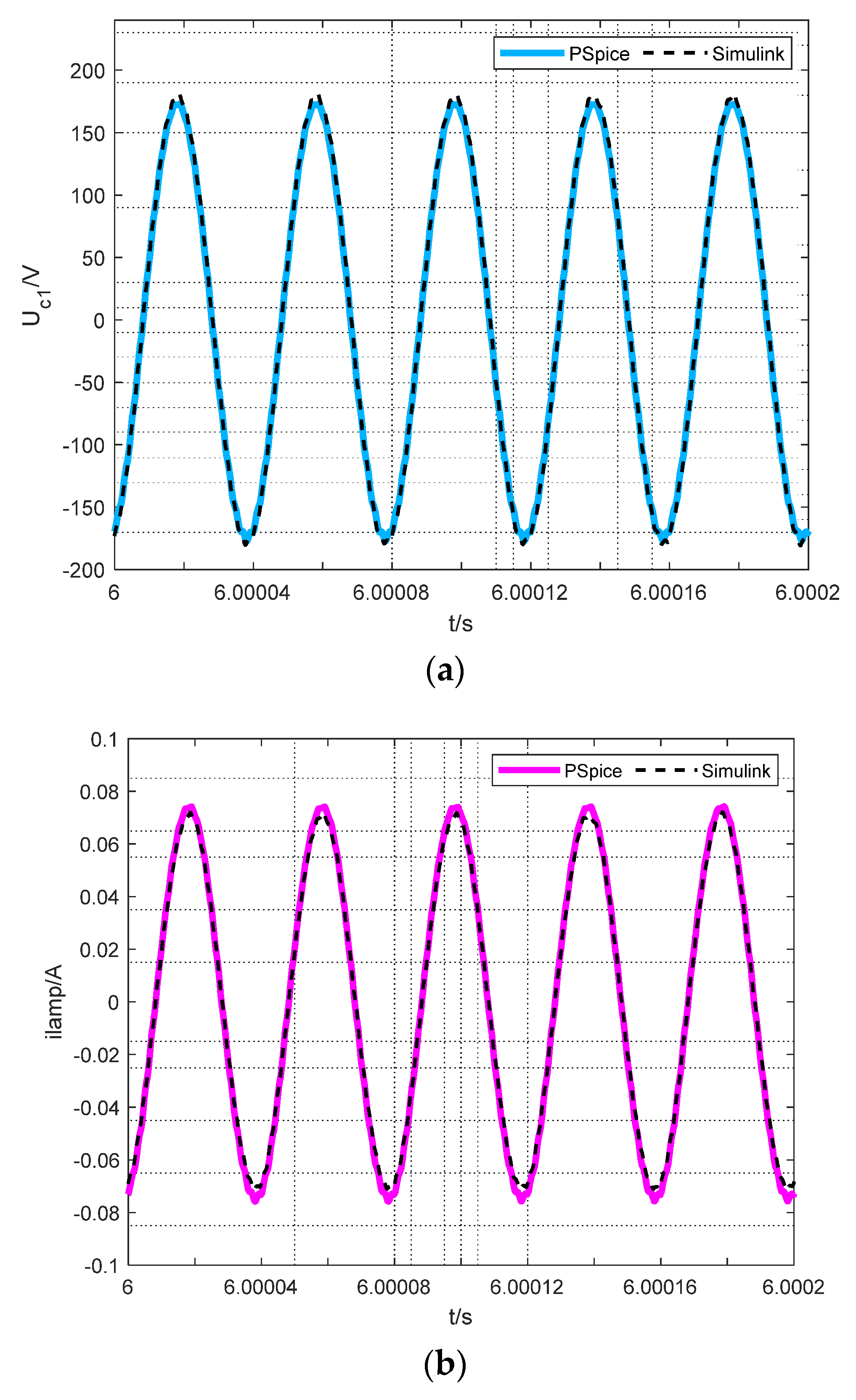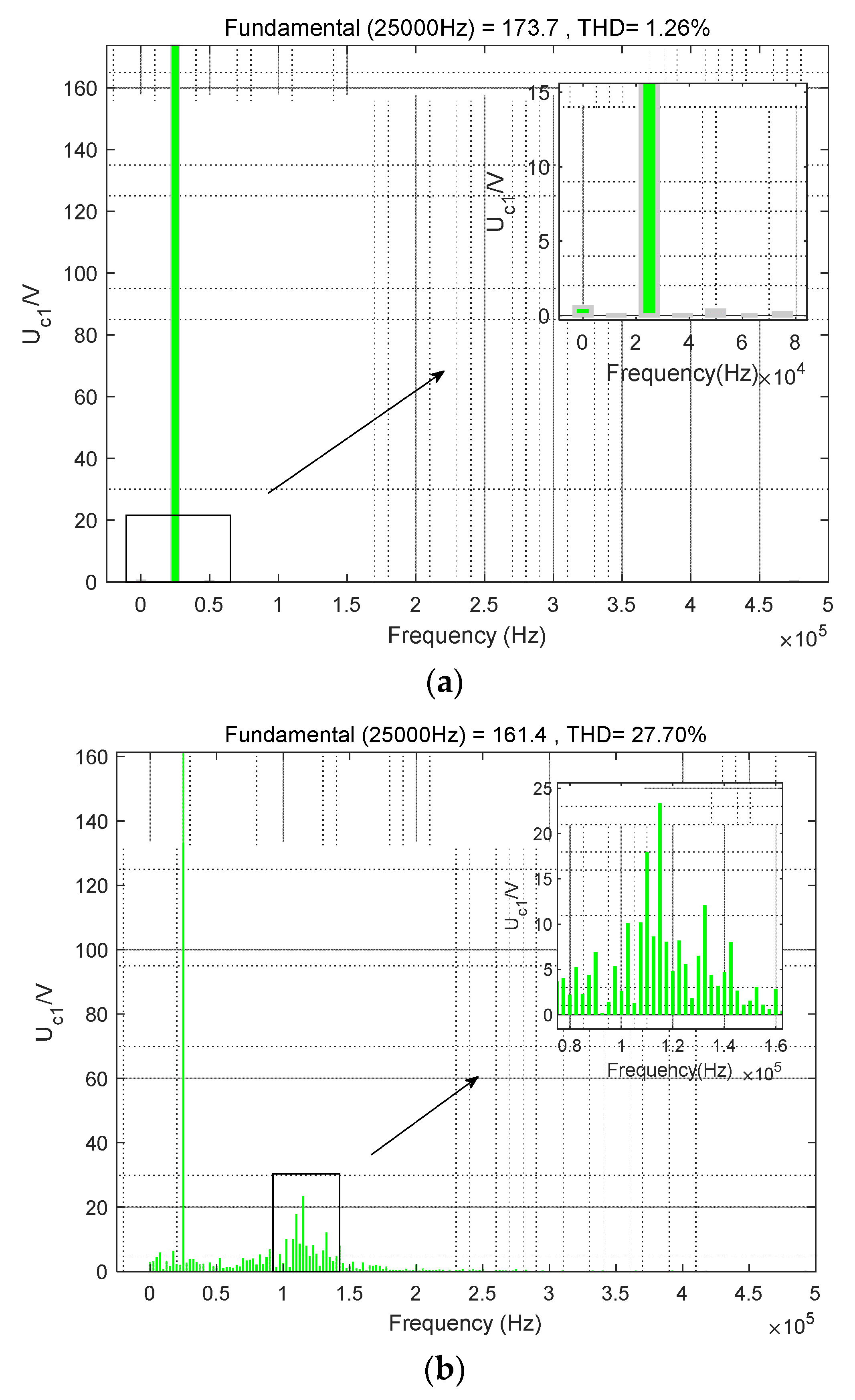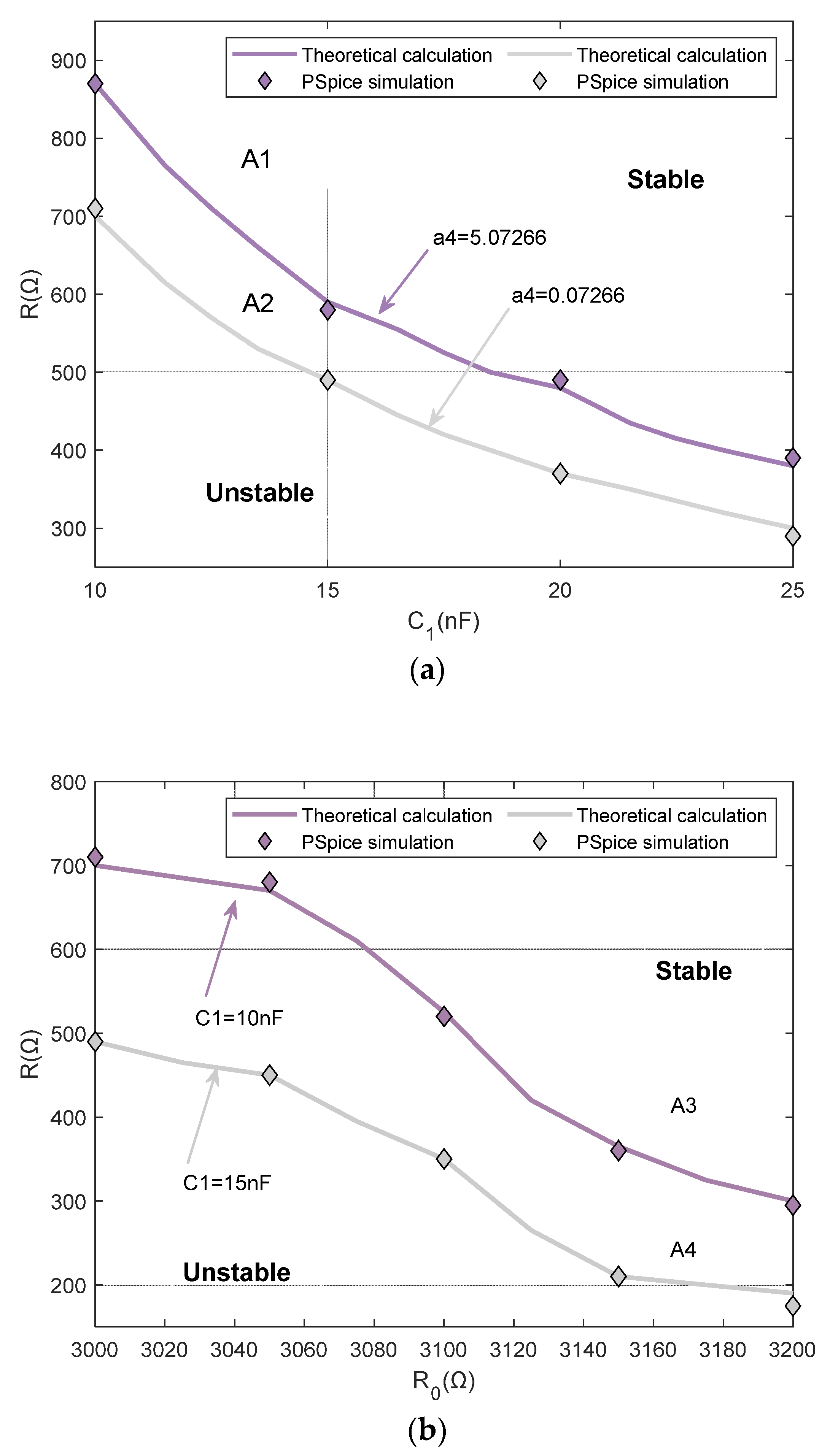1. Introduction
In 1971, according to the symmetry and completeness principle of circuit theory, Chua LO proposed the concept of the memristor, which describes the relationship between the charge and the magnetic flux and is called the fourth basic circuit element [
1]. The proposal of the memristor concept increased the number of fundamental circuit elements from three to four, thereby enriching and completing the theoretical framework of circuit theory. Moreover, Chua LO has expanded and refined the concept of the memristor. He classified all memristors into three classes called ideal, Generic, or Extended memristors [
2,
3,
4]. However, despite the proposal of the memristor concept, progress in the corresponding research was hindered by the absence of a physical entity. Until 2008, HP LABS successfully manufactured solid-state memristor devices based on nanoscale TiO
2 [
5]. Since then, the study of memristors and memristive systems has attracted more and more attention, resulting in a wealth of research achievements documented in the open literature. For example, Ventra MD extended the concept of memristors to include meminductors and memcapacitors [
6]. On this basis, Yin Z Y provided a more detailed explanation of the memristor, meminductor, and memcapacitor [
7]. Biolek Z studied the mechanism of the hysteretic curve of the memristor [
8] and proposed the method for calculating the area in the hysteretic curve of the memristor, which proved that the area of the pinched hysteresis loop of the current-controlled ideal memristor represents the quantity “content” introduced into the theory of nonlinear systems by Millar in 1951 [
9,
10]. In addition, according to the results on fluorescent lamps in the literature [
11], it can be seen that fluorescent lamps show the obvious memristor’s characteristics, which arouse people’s interest. For example, based on the theoretical analysis of low-pressure discharge in the positive column region and the Francis equation, Dai Guojun proposed a PSpice model of a fluorescent lamp [
12]. Based on gas discharge theory, Wei Yan established a semi-theoretical model of a fluorescent lamp that fully accords with the definition of a fluid-controlled memristor. The model can predict the electrical characteristics of different types of fluorescent lamps at different operating frequencies and different dimming levels [
13]. On the basis of the literature [
13], D. Lin used a unified mathematical framework to build mathematical models of high-pressure and low-pressure gas discharge lamps and pointed out that both high-pressure and low-pressure gas discharge lamps have memristor characteristics [
14]. Based on [
14], S. P. Adhikari briefly analyzed the non-crossing characteristics of the hysteresis loops of fluorescent lamps at the origin [
15].
Moreover, a considerable number of electrical devices have been experimentally identified as belonging to the category of memristive systems. These devices include; however, are not limited to, thermistors, tungsten filament lamps, current-controlled discharge tubes, and first-generation radio detectors [
2,
16,
17]. Additionally, certain commonly encountered circuit systems have exhibited memristive characteristics in their external behavior during energization. For instance, in a significant study conducted in 2012, Corinto and Ascoli demonstrated that a diode bridge post-connected with an LCR filter can manifest memristive external characteristics, leading to its designation as a memristive diode bridge circuit [
18]. It is foreseeable that in the future, an increasing number of electrical devices exhibiting memristive characteristics will be discovered or manufactured. Memristive electrical devices require operating in an alternating current environment devoid of direct current bias. The inverter circuits are power electronic conversion circuits capable of converting DC to AC power and serve as vital power sources for memristive electrical devices. Due to the transitions between different states of the power switches, the inverter itself operates as a segmented circuit, exhibiting intricate nonlinear phenomena.
Currently, research on complex nonlinear phenomena in inverters has become widespread. In 2002, Robert et al. first extended the study of nonlinear complex behaviors to the realm of DC/AC converters, analyzing boundary-collision bifurcations and chaos phenomena in single-phase H-bridge inverters [
19]. In 2006, Kousaka et al. conducted an analysis of period orbit stability in single-phase H-bridge inverters using the return map method. By using this map, the stability of the periodic orbit can be analyzed simply using the symbolic sequence [
20]. In 2009, Wang et al. established a first-order discrete model through iterative techniques and employed frequency-flashing mapping, folding mapping, and bifurcation mapping to describe bifurcation and chaos phenomena in proportional control single-phase H-bridge inverter systems [
21,
22]. In 2012, Wu et al. proposed control methods for fast-scale and slow-scale bifurcations in voltage-controlled H-bridge inverter circuits from a frequency-domain perspective [
23]. In 2013, Liu et al. investigated the symmetric phenomena of fast-scale bifurcations in peak current and valley current-controlled H-bridge inverter circuits. The simulation showed that the symmetrical dynamical phenomenon occurs in the single-phase H-bridge inverter controlled by the peak current or the valley current [
24]. In 2016, Zhang et al. proposed an improved averaging modeling method and analyzed the fast-scale bifurcation behavior in peak current-controlled Buck-Boost inverters. This method can increase the resolution of the conventional classic averaged model by half the switching frequency [
25]. However, despite the significant body of research in this area, it is worth noting that the majority of the aforementioned studies have predominantly concentrated on linear loads, and the stability analysis of inverters with memristive loads has not been extensively explored. Existing research findings have demonstrated that memristive loads have a certain impact on the dynamic characteristics of power electronic circuits [
26,
27,
28]. Due to the nonlinear characteristics of memristors, the full-bridge inverter with memristive loads exhibits nonlinearity during the periods of power switching on and off, indicating that it is a piecewise nonlinear system. Furthermore, in comparison with inverters having linear loads, the memristive nature of memristors leads to an increase in the system’s order. This complexity contributes to a range of nonlinear behaviors and challenges, thus amplifying the intricacy and difficulty of system parameter design. Some investigations have resorted to approximating memristive loads as linear loads for the sake of simplicity [
29]. Such oversimplified approaches inevitably overlook the intricate and unique characteristics inherent in inverters with memristive loads, thereby hindering their ability to provide comprehensive guidance for the precise design and optimization of these specialized systems.
Therefore, the stable operation of inverters with memristive loads becomes a pivotal foundation driving the advancement and application of memristors and is poised to emerge as a crucial issue in the future. Fluorescent lamps, as the most common memristive electrical devices, exhibit significant representativeness. In practical applications, an inverter supplies high-frequency AC power to fluorescent lamps to drive their stable operation [
30]. However, both fluorescent lamps and inverters are strong nonlinear systems, leading to the full-bridge inverter with the fluorescent lamp being a class of strongly nonlinear systems in which there must be a wealth of complex nonlinear phenomena, such as bifurcation, chaos, and so on, leading to greater noise and instability, not conducive to practical engineering applications. Therefore, a comprehensive investigation into the nonlinear dynamic behavior of the inverter with a fluorescent lamp load not only serves as a valuable reference for better comprehension and enhancement of system design but also contributes to the advancement of memristive device applications in power electronic circuits.
Addressing the aforementioned issues and limitations, this paper establishes a mathematical model for a full-bridge inverter system with a fluorescent lamp, taking into account the memristive characteristics of the fluorescent lamp. Through Matlab/Simulink simulations, we identify the presence of low-frequency oscillations in the system. Employing the harmonic balance method and Floquet theory, it elucidates the fundamental mechanism of these oscillations and outlines the system’s stability boundaries across various parameter planes. Furthermore, a PSpice simulation model is constructed, yielding results consistent with theoretical analysis, thus validating the accuracy of the theoretical insights.
2. Mathematical Modeling and Simulations
In 2007, Wei Yan et al. established the mathematical model of a fluorescent lamp through experiments and a genetic algorithm [
14], namely
where
t is the time,
e is the charge on the electron, and
e = 1.6 × 10
−19 C,
k is the Boltzmann constant, and
k = 1.38 × 10
−23 J/K,
T is the electron temperature, and the initial value of
T is
= 350 K, and
a1–
a6 are the adjustable model coefficients.
Based on the classification of memristors in Ref. [
31], the mathematical model of a fluorescent lamp conforms to the constitutive relation of a current-controlled memristor, whose memristor value is
The second and third expressions of (1) are transcendental functions with respect to
T, which will bring difficulties to theoretical calculation and analysis. Here, according to the model parameters given in Ref. [
15], the approximate fitting is performed on equations
a5T−0.75exp(
ea6/(2
kT)) and
a2exp(−
ea3/(
kT)). That is,
As can be seen from
Figure 1, the fitting R-square of
a5T−0.75exp(
ea6/(2
kT)) is 0.9944, and the fitting R-square of
a2exp(−
ea3/(
kT)) is 0.9998, which shows that the fitting accuracy is very high. Thus, it is effective to use the simplified model instead of
a5T−0.75exp(
ea6/(2
kT)) and
a2exp(−
ea3/(
kT)).
Generally speaking, the operational frequency of fluorescent lamps typically ranges from 20 kHz to 100 kHz. A high-frequency AC power supply enables fluorescent lamps to produce more stable and uniform illumination, thereby reducing visible flickering. In electronic ballasts, the high-frequency AC power is generated by the inverter circuit. Therefore, the inverter is the most basic and critical component of the electronic ballast, and the full-bridge inverter is one of the most common topologies. Therefore, here, the PI current feedback-controlled full-bridge inverter is used to drive a fluorescent lamp as the research object, and its circuit model is shown in
Figure 2. This circuit is mainly composed of the DC voltage source
E, power switches Q1~Q4, LCC (LCC is a circuit topology consisting of an inductor and two capacitors, hence its name LCC) branch, the fluorescent lamp load, and the current feedback controller. The control section adopts the SPWM (Sinusoidal Pulse Width Modulation) current control mode, where the output current
iL is compared with the reference current
iref. The error signal resulting from this comparison is fed into a PI controller to obtain the modulating signal
ic. This modulating signal
ic is then compared with a triangular wave
it to generate a driving signal, which is used to control the on-off of the power switches. When the driving signal is high, the corresponding power switches are on; otherwise, they are off. Note that Q1 and Q4 have the same drive signals, as do Q2 and Q3. Note that the insulation resistance
Rc2 of capacitor
C2 is considered (note:
Rc2 stands for loss in the dielectric, and
Rc2 is usually large, generally above 1 MΩ [
32,
33]).
The bipolar SPWM generator in
Figure 2 consists of a COM (Comparator), a triangular carrier
it, and a power switch driver. Note that the chosen operating frequency
f0 for the fluorescent lamp is
f0 = 25 kHz, which results in ω
0 = 2π
f0 = 50,000π, And the triangular carrier
it and reference current
iref are presented as follows:
where
and
are the angular frequency and amplitude of the triangular carrier respectively.
The output of a comparator is high; otherwise, it is low. According to KCL (Kirchhoff’s Current Law) and KVL (Kirchhoff’s Voltage Law) [
34], the mathematical model of the system described by the differential equation can be derived as follows:
When
S = 1, means Q1 and Q4 are turned on, and Q2 and Q3 are turned off. On the contrary, Q2 and Q3 are turned on, and Q1 and Q4 are turned off. According to Formula (5), the MATLAB/Simulink simulation model of the full-bridge inverter system with the fluorescent lamp is established, as shown in
Figure 3. As indicated by Equation (5) and
Figure 3 in the original manuscript, it can be observed that when a fluorescent lamp is connected, compared to an inverter with a linear load, the memristive nature of the lamp leads to an increase in the system’s order. Usually, power electronic systems can be regarded as segmented linear switching circuits. However, due to the memristive characteristics of fluorescent lamps, the full-bridge inverter with fluorescent lamps exhibits nonlinearity during the periods of power switching on and off. In other words, the full-bridge inverter with fluorescent lamp is a segmented nonlinear system that is more complicated and more prone to generating oscillations and other nonlinear behaviors.
In actual electronic ballasts, the amplitude of the rectified DC voltage is around 300 V; hence, we opted for
E = 300 V. The inductance
L of the LCC branch is on the order of millihenries (mH), while both
C1 and
C2 have values in the nanofarad (nF) range. The electronic ballast achieves high-voltage ignition of the fluorescent lamp through the resonance of the
LCC branch. The resonance frequency for ignition (
fres1) should be higher than the operating frequency of the fluorescent lamp. And to ensure that the LCC branch operates in an inductive state, the operating frequency of the fluorescent lamp needs to be higher than the steady-state resonance frequency (
fres2).
Choosing C1 = 10 nF, C2 = 100 nF, and L = 1.5 mH can meet the requirements. The other circuit parameters are selected as Iref = 0.3 V, C = 0.047 nF, R0 = 3 kΩ, Itri = 1 V.
Figure 4 shows the Matlab/Simulink simulation results under
R = 5 kΩ. In
Figure 4a,
Uc1 is the time-domain waveform of the voltage across the fluorescent lamp, while
Figure 4b is the time-domain waveform of the current through the fluorescent lamp. From
Figure 4, it is obvious that the system is in stable operation. However, the system is unstable and in a state of low-frequency oscillation when
R = 50 Ω, which is shown in
Figure 5. Obviously, the resistance
R has an important effect on the occurrence of low-frequency oscillation in the fluorescent lamp system driven by the full bridge inverter.
4. PSpice Simulations
In order to verify the theoretical analysis, a simulation circuit model of a full-bridge inverter with a fluorescent lamp was constructed in PSpice. The circuit parameters are the same as those in
Section 3.1, where LF356 is selected for the operational amplifier and LM311 for the comparator.
Figure 8 shows the time-domain waveform of the voltage across the fluorescent lamp and the current through it when
R = 5 kΩ, and the system is in stable operation.
Figure 9 shows the PSpice simulations for
R = 50 Ω. It is clear that the system is operating in an unstable state. For the purpose of comparison, the black dashed lines in
Figure 8 and
Figure 9 represent the simulation results from Matlab/Simulink in
Figure 4 and
Figure 5. After comparing
Figure 8 and
Figure 9 with
Figure 4 and
Figure 5, respectively, it is found that the PSpice simulations are consistent with those of MATLAB/Simulink simulations, which effectively verifies the correctness of the theoretical analysis.
In addition, by importing the data into MATLAB and selecting a fundamental frequency of 25 kHz for spectrum analysis, the harmonic spectrum of voltage
Uc1 can be obtained. As depicted in
Figure 10a, it can be observed that when the resistance
R is 5 KΩ, the total harmonic distortion (THD) of the output voltage
Uc1 is measured at 1.21% within the frequency range of 0–500 kHz. Remarkably, the harmonics exhibit smaller amplitudes compared to the fundamental frequency, with each harmonic amplitude approximating 0 V. However, when the resistance
R is 50 Ω, the THD of the output voltage
Uc1 significantly increases to 27.70%. Under this condition, the system exhibits oscillations; the oscillation frequency is mainly around 110 KHz which is between the operating frequency of 25 kHz and the switching frequency of 500 kHz. This oscillation phenomenon can be called “low-frequency oscillation”. In the region of the oscillation frequency, the voltage
Uc1 has larger harmonics. Therefore, the occurrence of low-frequency oscillation will make the fluorescent lamp work in harsh environments.
Figure 11a shows the stability boundary of the system obtained by PSpice simulations and theoretical calculations in the
C1-
R parameter plane under different parameters
a4, indicating that with the decrease of capacitor
C1 or resistance
R, the full-bridge inverter with the fluorescent lamp is more prone to instability. In addition, when
a4 = 0.07266, the stable region is A1 + A2, while when
a4 = 5.07266, the stable region decreases to region A1. Therefore, the stability region of the system will decrease with the increase of the parameter
a4.
Figure 11b shows the stability boundary of the system obtained by PSpice simulations and theoretical calculations in the
R0-
R parameter plane under different capacitance
C1, indicating that the full-bridge inverter with the fluorescent lamp is more prone to instability with the decrease of resistance
R0 or
R. In
Figure 11b, when
C1 = 15 nF, the stable region is A3 + A4, while when
C1 = 10 nF, the stable region is reduced to region A3. Thus, the stable region of the system will increase with the increase of the capacitance
C1. Based on the stability boundaries of the system, it is possible to optimize the parameter design of the system, thereby reducing the risk of system oscillation or even failure, and enhancing the reliability and stability of the system.
